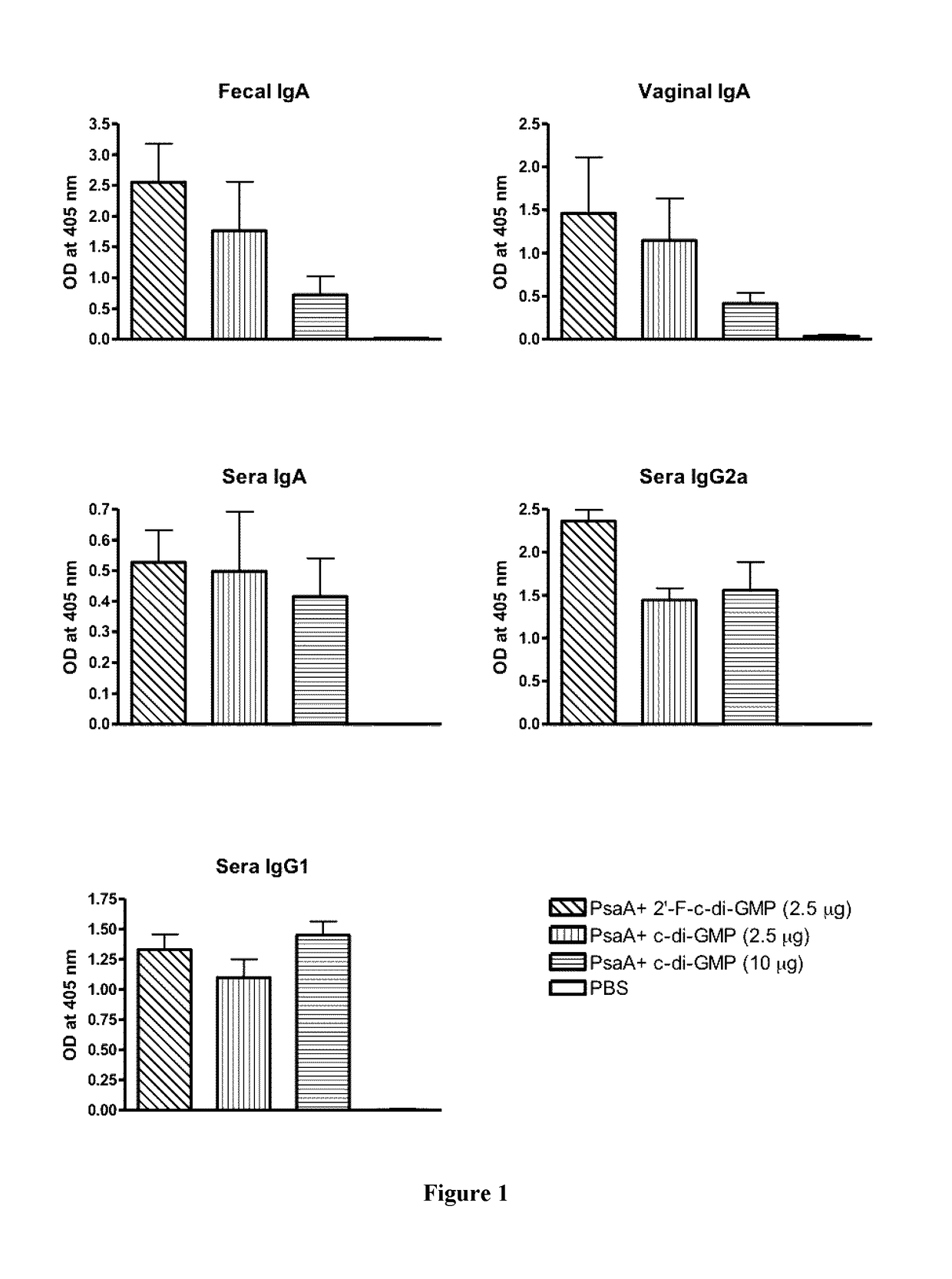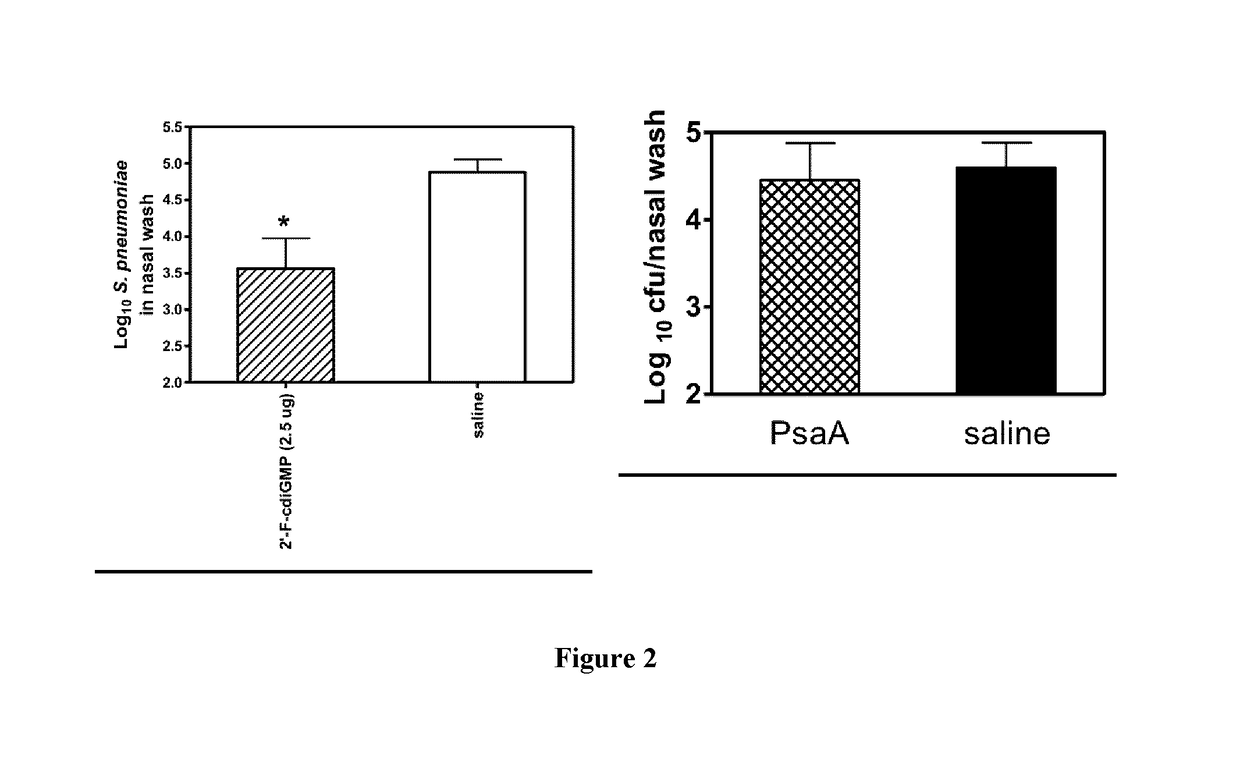Use of fluorinated cyclic dinucleotides as oral vaccine adjuvants
a technology of fluorinated cyclic dinucleotides and oral vaccines, which is applied in the direction of antibacterial agents, immunological disorders, antibody medical ingredients, etc., can solve the problems of only demonstrating limited ability to elicit protective mucosal immunity, failing to prevent infection in the gi tract or in the tonsils, and increasing the unmet demand for effective mucosal vaccination
- Summary
- Abstract
- Description
- Claims
- Application Information
AI Technical Summary
Benefits of technology
Problems solved by technology
Method used
Image
Examples
example 1
Intranasally Administered 2′-F-c-di-GMP Induces Strong Antigen-specific Antibody Responses in the Serum and at Multiple Mucosal Sites
[0097]To determine if 2′-F-c-di-GMP can elicit mucosal immune responses to microbial (bacterial and viral) antigens, groups of BALB / c mice were intranasally (i.n.) immunized with 2 μg recombinant PsaA protein of S. pneumoniae admixed with 2.5 μg 2′-F-c-di-GMP, 2.5 μg c-di-GMP, or 10 μg c-di-GMP at day 0, 14 and 21. An additional group of mice was sham-immunized with PBS only. The blood and mucosal samples (fecal pellets and vaginal wash) were collected at day 28 and assayed for PsaA-specific IgA, IgG1 and IgG2a by standard ELISA. As seen in FIG. 1, co-administration of PsaA with 2′-F-c-di-GMP induced high level of PsaA-specific IgA in feces, nasal wash, and serum as well as serum IgG1 and IgG2a levels. As expected, sham-immunized mice showed no specific antibody responses in the serum or mucosal samples as shown in FIG. 1. The results showed that, comp...
example 2
Intranasal Immunization of Mice with 2′-F-c-di-GMP-adjuvanted PsaA Reduces Nasopharyngeal Colonization by S. Pneumoniae
[0098]Next, it was determined if the mucosal immune responses induced by the 2′-F-c-di-GMP adjuvanted vaccine are protective against mucosal infections in the well-established mouse S. pneumoniae colonization model. Groups of immunized (PsaA+2′-F-c-di-GMP) or sham-immunized (saline only) mice were intranasally challenged with 4.55×106 CFU S. pneumoniae at day 35 after the first immunization. Mice were sacrificed 3 days after challenge, and the nasopharyngeal tract was lavaged and bacterial numbers in the nasal wash were determined. As seen in FIG. 2 (left panel), results from quantitative bacteriology showed significantly reduced colonization of S. pneumoniae in PsaA+2′-F-c-di-GMP immunized mice when compared to sham-immunized mice (PCyclic diguanylic acid elicits mucosal immunity against bacterial infection. Biochemical and Biophysical Research Communications. 200...
example 3
Oral Immunization with 2′-F-cdiGMP-adjuvanted Vaccine Induces Strong Antigen-specific Antibody Responses in the Serum and at Multiple Mucosal Sites
[0099]To determine if oral administration of 2′-F-c-di-GMP can induce mucosal immune responses to microbial (bacterial and viral) antigens, groups of C57BL / 6 mice (n=5) were orally immunized with varying amounts (125-500 μg) of HPCE admixed with 100 μg 2′-F-c-di-GMP, or 500 μg HPCE admixed with 10 μg CT at day 0, 14 and 21. Additional group of mice was sham-immunized with PBS only. The blood and fecal pellets were collected at day 28 and assayed for HPCE-specific IgA, IgG1 and IgG2a by standard ELISA. As it can been seen in FIG. 3, co-administration of both high and low doses of HPCE with 2′-F-c-di-GMP induced substantial amount of antigen-specific IgA levels in feces and serum as well as serum IgG1 and IgG2a levels. The results showed that, compared with sham-immunized mice, 2′-F-c-di-GMP induces substantially higher antigen-specific IgA...
PUM
| Property | Measurement | Unit |
|---|---|---|
| surface area | aaaaa | aaaaa |
| optical density | aaaaa | aaaaa |
| optical density | aaaaa | aaaaa |
Abstract
Description
Claims
Application Information
 Login to View More
Login to View More - R&D
- Intellectual Property
- Life Sciences
- Materials
- Tech Scout
- Unparalleled Data Quality
- Higher Quality Content
- 60% Fewer Hallucinations
Browse by: Latest US Patents, China's latest patents, Technical Efficacy Thesaurus, Application Domain, Technology Topic, Popular Technical Reports.
© 2025 PatSnap. All rights reserved.Legal|Privacy policy|Modern Slavery Act Transparency Statement|Sitemap|About US| Contact US: help@patsnap.com



